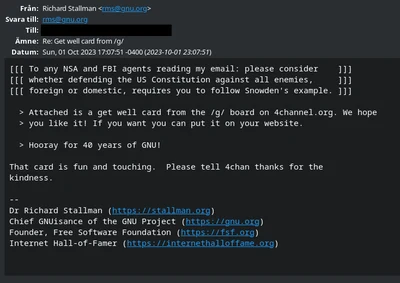5 billion people use the internet.
— Misha (@MishaDaVinci) July 24, 2022
Less than 1% understand it.
This mega thread will get you up to speed—starting today:
Are you one of the less than 1% that understand the internet?
- 38
- 42
Top Poster of the Day:

 AverageTopPosterEnjoyer
AverageTopPosterEnjoyer


Current Registered Users: 26,826

tech/science swag. 
Guidelines:
What to Submit
On-Topic: Anything that good slackers would find interesting. That includes more than /g/ memes and slacking off. If you had to reduce it to a sentence, the answer might be: anything that gratifies one's intellectual laziness.
Off-Topic: Most stories about politics, or crime, or sports, unless they're evidence of some interesting new phenomenon. Videos of pratfalls or disasters, or cute animal pictures. If they'd cover it on TV news, it's probably lame.
Help keep this hole healthy by keeping drama and non-drama balanced. If you see too much drama, post something that isn't dramatic. If there isn't enough drama and this hole has become too boring, POST DRAMA!
In Submissions
Please do things to make titles stand out, like using uppercase or exclamation points, or saying how great an article is. It should be explicit in submitting something that you think it's important.
Please don't submit the original source. If the article is behind a paywall, just post the text. If a video is behind a paywall, post a magnet link. Fuck journos.
Please don't ruin the hole with chudposts. It isn't funny and doesn't belong here. THEY WILL BE MOVED TO /H/CHUDRAMA
If the title includes the name of the site, please leave that in, because our users are too stupid to know the difference between a url and a search query.
If you submit a video or pdf, please don't warn us by appending [video] or [pdf] to the title. That would be r-slurred. We're not using text-based browsers. We know what videos and pdfs are.
Make sure the title contains a gratuitous number or number + adjective. Good clickbait titles are like "Top 10 Ways to do X" or "Don't do these 4 things if you want X"
Otherwise editorialize. Please don't use the original title, unless it is gay or r-slurred, or you're shits all fucked up.
If you're going to post old news (at least 1 year old), please flair it so we can mock you for living under a rock, or don't and we'll mock you anyway.
Please don't post on SN to ask or tell us something. Send it to [email protected] instead.
If your post doesn't get enough traction, try to delete and repost it.
Please don't use SN primarily for promotion. It's ok to post your own stuff occasionally, but the primary use of the site should be for curiosity. If you want to astroturf or advertise, post on news.ycombinator.com instead.
Please solicit upvotes, comments, and submissions. Users are stupid and need to reminded to vote and interact. Thanks for the gold, kind stranger, upvotes to the left.
In Comments
Be snarky. Don't be kind. Have fun banter; don't be a dork. Please don't use big words like "fulminate". Please sneed at the rest of the community.
Comments should get more enlightened and centrist, not less, as a topic gets more divisive.
If disagreeing, please reply to the argument and call them names. "1 + 1 is 2, not 3" can be improved to "1 + 1 is 3, not 2, mathfaggot"
Please respond to the weakest plausible strawman of what someone says, not a stronger one that's harder to make fun of. Assume that they are bad faith actors.
Eschew jailbait. Paedophiles will be thrown in a wood chipper, as pertained by sitewide rules.
Please post shallow dismissals, especially of other people's work. All press is good press.
Please use Slacker News for political or ideological battle. It tramples weak ideologies.
Please comment on whether someone read an article. If you don't read the article, you are a cute twink.
Please pick the most provocative thing in an article or post to complain about in the thread. Don't nitpick stupid crap.
Please don't be an unfunny chud. Nobody cares about your opinion of X Unrelated Topic in Y Unrelated Thread. If you're the type of loser that belongs on /h/chudrama, we may exile you.
Sockpuppet accounts are encouraged, but please don't farm dramakarma.
Please use uppercase for emphasis.
Please post deranged conspiracy theories about astroturfing, shilling, bots, brigading, foreign agents and the like. It degrades discussion and is usually mistaken. If you're worried about abuse, email [email protected] and dang will add you to their spam list.
Please don't complain that a submission is inappropriate. If a story is spam or off-topic, report it and our moderators will probably do nothing about it. Feed egregious comments by replying instead of flagging them like a pussy. Remember: If you flag, you're a cute twink.
Please don't complain about tangential annoyances—things like article or website formats, name collisions, or back-button breakage. That's too boring, even for HN users.
Please seethe about how your posts don't get enough upvotes.
Please don't post comments saying that rdrama is turning into ruqqus. It's a nazi dogwhistle, as old as the hills.
Miscellaneous:
We reserve the right to exile you for whatever reason we want, even for no reason at all! We also reserve the right to change the guidelines at any time, so be sure to real them at least once a month. We also reserve the right to ignore enforcement of the guidelines at the discretion of the janitorial staff. Be funny, or at least compelling, and pretty much anything legal is welcome provided it's on-topic, and even then.
[[[ To any NSA and FBI agents reading my email: please consider ]]]
[[[ whether defending the US Constitution against all enemies, ]]]
[[[ foreign or domestic, requires you to follow Snowden's example. ]]]
/h/slackernews LOG /h/slackernews MODS /h/slackernews EXILEES /h/slackernews FOLLOWERS /h/slackernews BLOCKERS








Jump in the discussion.
No email address required.
I understand even less now. All she did was throw around a bunch of buzzwords and then jump to web3. How does the internet actually work?
Jump in the discussion.
No email address required.
I can try to explain
basically, the internet is a bunch of interconnected computers. Each of the computers has an unique identifier, the IP address. You get your IP address from your ISP. Using the border gate protocol (bgp), a rather sophisticated algorithm, it is possible to find the fastest route to the target ip address. This way, two nodes are able to exchange messages
However these messages are sent in raw ethernet sockets, which is quite unreliable and almost never used today. Instead, we use a protocol that forms an abstraction layer over raw ethernet sockets. By far the most common ones are TCP and UDP. This is also where ports are implemented. There are TCP ports, as well as UDP ports.
TCP is used whenever reliable communication is needed. When first establishing connection, the two nodes go through a three way handshake to prevent IP impersonation and such. After this, a tcp connection is established. TCP will periodically check that both are still connected and whenever a message is sent, tcp will make sure that it is received and not corrupted in an way.
The most common example for the usage of TCP are websites. They use HTTP, a very simple abstraction layer. HTTP is run on the TCP port 80. Instead of mutual messaging, HTTP uses a request-respond model. First your browser sends a http request. This may look something like this
After receiving the request, the server responds with the requested content:
The HTTPS protocol is basically the same, except that it is encrypted with SSL. It is responsible for the green padloock that signals you that the website is secure.
UDP is used when speed is prioretized over reliability, for example in games. It doesn't matter if one movement packet times out. There is no connection or server in UDP, you just send some messages to a UDP port of the target and it might send some messages back. Another use case of UDP is the DNS protocol. The DNS protocol is needed to convert a domain into an ip address. For example when I run
nslookup google.com, I get the answer:and indeed when we open this ip address in our browser it leads us to google.
Jump in the discussion.
No email address required.
Sorry ma'am, looks like his delusions have gotten worse. We'll have to admit him.
Jump in the discussion.
No email address required.
More options
Context
More options
Context
More options
Context